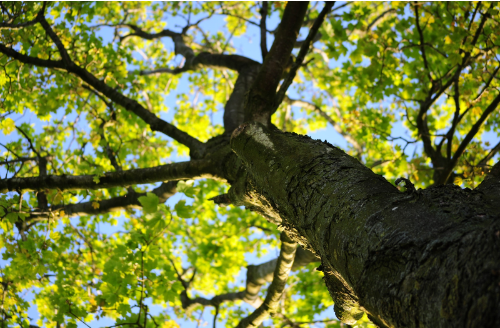Tree maintenance experts can help you know how to prune
Tree maintenance experts in Round Rock and Austin TX can help you improve your landscape. Tree pruning is a fundamental practice in arboriculture, serving as a cornerstone for maintaining the health, aesthetics, and safety of trees. While it may seem like a straightforward task, proper pruning requires knowledge of tree biology, growth patterns, and pruning techniques. In this article, we delve into the basics of tree pruning as an essential practice for tree maintenance.
- Promoting Tree Health
One of the primary reasons for pruning trees is to promote their overall health. By removing dead, diseased, or damaged branches, tree pruning prevents the spread of pathogens and decay throughout the tree. These unhealthy branches not only compromise the tree’s structural integrity but also serve as entry points for pests and diseases. By eliminating them, pruning encourages the tree to allocate resources towards healthy growth and defense mechanisms.
- Enhancing Aesthetics
Beyond health benefits, tree pruning plays a crucial role in enhancing the aesthetic appeal of landscapes. Proper pruning can shape trees, desirably directing their growth. Whether it’s maintaining a balanced canopy, creating a specific form, or enhancing the view, strategic pruning can transform the visual appeal of trees and complement the overall landscape design.
- Ensuring Structural Integrity
Trees with weak or improper branching structures are susceptible to breakage, especially during storms or high winds. Tree pruning helps mitigate this risk by removing structurally weak branches and reducing the likelihood of failure. By promoting a strong central leader and well-spaced branches, pruning enhances the tree’s structural integrity, making it more resilient to environmental stresses.
- Preventing Hazards
Overgrown or poorly maintained trees can pose significant hazards to property and people. Dead branches, low-hanging limbs, and excessive foliage can obstruct pathways, utility lines, and structures, increasing the risk of accidents and property damage. Regular pruning eliminates these hazards, creating safer environments for both residents and visitors.
- Encouraging Fruit Production
In orchards and fruit-bearing trees, pruning plays a vital role in maximizing fruit production and quality. By selectively removing branches and promoting optimal light penetration and airflow, pruning stimulates fruiting wood growth, improves fruit size and flavor, and facilitates harvesting. Proper pruning also helps manage tree vigor, ensuring a balance between vegetative growth and fruit production.
Key Principles and Techniques of Tree Pruning
While the benefits of tree pruning are clear, achieving desired outcomes requires adherence to key principles and techniques. Understanding these fundamentals is essential for effectively managing tree growth and health through pruning practices.
- Timing of Pruning
Timing plays a crucial role in the success of tree pruning efforts. While dead or diseased branches can be pruned at any time of the year, structural pruning is best performed during the dormant season, typically in late winter or early spring. Pruning during dormancy minimizes stress on the tree and reduces the risk of disease transmission. However, certain species may have specific timing requirements, so it’s essential to research the optimal pruning window for each tree.
- Selective Branch Removal
Selective branch removal is a fundamental principle of tree pruning, emphasizing the strategic removal of specific branches to achieve desired outcomes. When selecting branches for removal, prioritize those that are dead, diseased, or damaged, as well as those that pose safety hazards or interfere with the tree’s structure. Avoid indiscriminate or excessive pruning, as it can stress the tree and compromise its health and aesthetics.
- Pruning Techniques
Several pruning techniques are commonly used to achieve specific objectives:
- Thinning: Thinning involves selectively removing branches to reduce canopy density and improve light penetration and airflow. This technique is particularly beneficial for promoting tree health and reducing wind resistance.
- Heading: Heading involves cutting back the tips of branches to promote branching and denser growth. While useful for shaping and rejuvenating overgrown trees, excessive heading can lead to weak, structurally unsound growth.
- Directional Pruning: Directional pruning involves guiding the growth of branches in a specific direction by selectively removing competing or undesirable branches. This technique is often used to train young trees and manage their form and structure.
- Proper Pruning Tools
Using the right tools is essential for safe and effective pruning. Common pruning tools include hand pruners, loppers, pruning saws, and pole pruners, each designed for specific pruning tasks and branch sizes. Ensure that pruning tools are sharp, clean, and properly maintained to minimize damage to the tree and promote rapid healing of pruning wounds.
- Considerations for Tree Species
Different tree species have unique growth habits, responses to pruning, and susceptibility to certain diseases. When pruning trees, consider the specific characteristics and requirements of each species to ensure optimal results. Research the recommended pruning practices for the target species and adapt techniques accordingly to promote healthy growth and longevity.
- Monitoring and Maintenance
After pruning, it’s essential to monitor the tree’s response and conduct regular maintenance to ensure continued health and vitality. Inspect the pruned areas for signs of healing and monitor the tree’s growth and structure over time. Conduct periodic inspections to identify any new issues or hazards that may require pruning attention. Additionally, continue routine maintenance practices such as watering, mulching, and fertilizing to support the tree’s overall well-being and resilience against environmental stressors. By staying proactive in monitoring and maintenance, you can maximize the benefits of tree pruning and sustain a thriving landscape.
In conclusion, tree pruning is a critical practice for maintaining the health, aesthetics, and safety of trees in urban and natural environments. By understanding the importance of pruning, adhering to key principles and techniques, and considering the unique characteristics of tree species, arborists and homeowners can effectively manage tree growth and promote the long-term vitality of their landscapes.
Hire the best tree maintenance experts in Round Rock and Austin TX
Leaf Tree Services is your locally owned professional tree service with certified arborists for residential and commercial customers in Round Rock, Austin, and surrounding Central Texas areas. You can trust your trees to us. Contact us today to schedule a consultation, at 512-670-6766.


